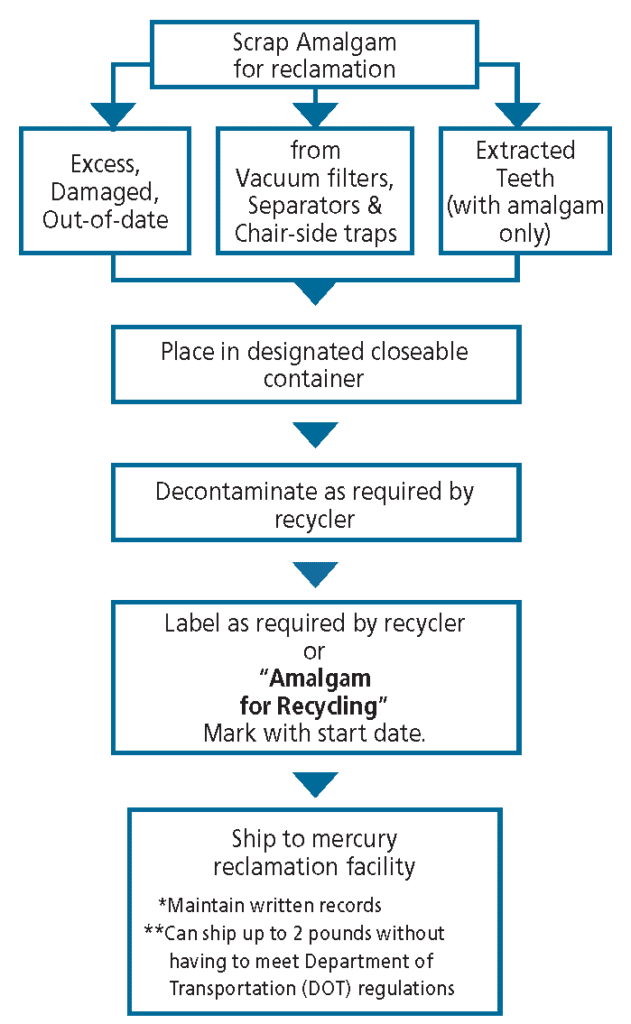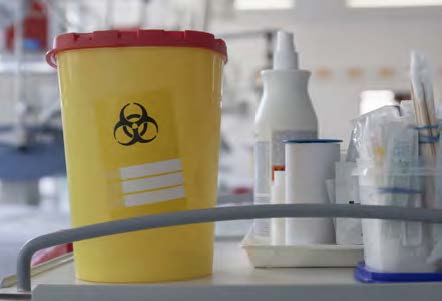Guide to Managing Dental Waste
This resource has been developed by Pinellas County Solid Waste to provide businesses with guidance on how to properly manage wastes in accordance with federal, state, and local laws.

Dental Offices can Go Green too!
Refuse:
- Refuse Junk Mail
- Register with the Mail Preference Service of the Direct Marketing Association
- Phone specific companies and ask to be taken off their mailing list
- Refuse to purchase products with excess packaging
- Patronize suppliers who minimize packaging or use recyclable packaging
Reduce:
- Purchase in bulk to reduce packaging waste
- Use digital technologies – go paperless as much as possible with suppliers and customers
- Use steam sterilization instead of chemicals
- Ask if patient wants a “goodie bag”
- Replace plastic goodie bag with small paper bag (brown sandwich bag)
Reuse:
- Switch from single-use paper bio-bibs to cloth
- Replace single use plastic products with re-usable stainless steel items
Examples: impression trays and suction tips
Purchase recycled content:
- Office paper
- Files folders
- Toilet paper
Best Management Practice for Scrap Amalgam


New Information
The Dental Amalgam Separator Rule (40 CFR Part 441) went into effect on July 14, 2017.
The rule requires most general dentists to install an amalgam separator in order to contain the release of
mercury.
Compliance date for the majority of dentists was July 14, 2020.
Requirements of the rule include:
- Ensure the removal of all dental amalgam from process wastewater using amalgam separator(s) (or equivalent device(s))
- Implement best management practices
- Comply with reporting requirements
- Maintain compliance documents and make available for inspection
The rule is mandatory with some specific exemptions.
For further information visit: www.epa.gov/eg/dental-effluent-guidelines
Frequently Asked Questions:
https://www.epa.gov/sites/default/files/2017-12/documents/dental-office-category_frequent-questions_nov-2017.pdf
Management of Regulated Wastes Typically Generated at Dental Facilities
Visit floridadep.gov/waste/permitting-compliance-assistance/content/hazardous-waste-management for information on hazardous waste disposal and recycling.
| Waste Type | Source | Disposal Options |
|
Amalgam See new Dental Amalgam Separator Rule on left |
|
1. Reclaimed via mercury
reclamation facility 2. Manage as hazardous waste |
| Empty Amalgam Capsule | Pre-capsulated amalgam use | 1. Dispose in trash |
| Fixer | X-ray process |
1. Take off-site for recycling 2. Treat before discharge to sewer (must recycle recovered silver) 3. Manage as hazardous waste |
| Unused Developer | X-ray process | 1. Manage as non-hazardous industrial waste; cannot be discharged to sewer system |
| X-ray Film | X-ray film | 1. Reclaim via metal reclamation facility |
Metals
|
X-ray process |
1. Reclaim via metal reclamation facility 2. Manage as hazardous waste |
Universal Wastes
|
Throughout facility |
1. Recycle via universal waste destination facility 2. Manage as hazardous waste |
| Waste or Bulk Mercury |
|
1. Reclaim via mercury reclamation facility 2. Manage as hazardous waste |
Compliance Tips
Written documentation of waste management/disposal is always recommended.
- Wastes recycled for their metal value, i.e. silver and mercury, do not count as hazardous waste toward your generator status.
- If you opt to use a silver recovery unit, check the unit daily for leaks, spills and overflows. Work closely with your supplier for help in developing a changeover schedule based on your volumes of silver-bearing solutions.
- Pinellas County and its municipalities have limitations on concentrations of pollutants, such as metals, discharged to the sewer system. Verify your wastewater discharge limits at www.municode.com.
- Amalgam waste should never be put in with biomedical (red bag) waste. For information on biomedical waste, visit www.floridahealth.gov.
- Never rinse amalgam traps over drains or discard in the garbage.
- Place mercury spill kits in convenient locations; never use a regular vacuum to clean up a mercury spill.
- Follow ANSI/ADA specification 109 requirements for amalgam waste storage and shipment.
Additional Resources
- Where Does It Go? Search Tool
- Recycle Guide & Downloadable Signage
- Household Chemical Collection
- Collection: Garbage & Recycling
- Hours: Solid Waste Disposal Complex
- Disposal Fee Information
- Educational Resources: Garbage and Recycling
- Recycling FAQ
- Map of Recycling Drop-Off Centers
- Artificial Reef Program
- Mulch Pickup Program
- For Businesses: Garbage & Recycling Resources
- How Mixed Recycling Works In Pinellas County
- Video Library: Garbage and Recycling
- Holiday and Gift-Giving Guide
- Pinellas Partners in Recycling
- Waste-to-Energy Facility
- Bridgeway Acres Landfill
- Solid Waste Master Plan
- Solid Waste Disposal Accounts
- Lealman Garbage and Recycling Collection
- Tampa Bay Recycles
- Why Recycling Is Important
- Discover Careers with Pinellas County Solid Waste
Contact Us
For more information or to request a printed copy of this guide, contact the Pinellas County Small Quantity Generator Program at (727) 464-7500 or bwa@pinellas.gov.